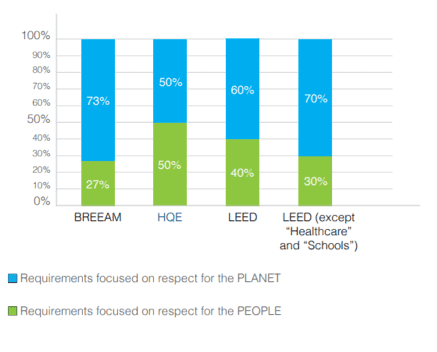
Thought
HQE (Haute Qualité Environnementale) certification for buildings in operation: how does it compare on health and wellbeing?
Although many may not be overly familiar with it (in comparison to the likes of BREEAM and LEED), HQE certification has the strongest presence in Europe by area, with buildings totalling approximately 85 million m2 certified at the end of 2017[1].
While HQE was first developed in France, the new international platform Cerway has brought it to an international audience.
Overall, HQE certification presents comparably comprehensive coverage of sustainable construction to BREEAM In-Use and LEED certifications, with a major focus on overall quality and assurance of the result. Additionally, HQE certifications present a non-prescriptive nature, which aims to rely less on application standards and specific thresholds, and rather account for local context and conditions, therefore providing a flexible, yet clear guidance.
HQE’s non-prescriptive focus addresses primarily:
1) Environmental and Energy Performance
2) Health and Comfort
In the first category, attention is focused on sustainable practices and management, with a particular distinction drawn between on the one hand, the intrinsic environmental quality of the asset, and on the other hand, the effectiveness of environmental practices.
The second category focuses upon the assets’ qualities that contribute to the health, comfort and wellbeing of its occupants.
So where does health and wellbeing fit in?
While BREEAM In-Use and LEED allocate substantial coverage to the environmental and energy aspects of a building, their coverage of health and wellbeing is to a lesser extent in comparison to HQE. HQE embraces both equally and provides an approach that aligns with current trends in the real estate sustainability sector. In my opinion, HQE has adopted a proactive approach which has foreseen and been able to react to the increasing need for stronger health and wellbeing monitoring. HQE’s direction aims to ensure that the assets will benefit equally from a reduction in energy consumption, good management of resources and better health and productivity for the occupiers. Hence, it has the potential to deliver long-lasting value for real estate investors and tenants, whilst providing enough flexibility on the “how” to achieve them through its non-prescriptive nature.

GBC, F. (2015). International Environmental Certifications for the Design and Construction of Non-Residential Buildings. Paris: France GBC, p. 4
Approximately 50% of the HQE certification focuses on health and wellbeing, whereas in BREEAM In-Use the scoring is split is 17% in part 1 and 15% for parts 2 and 3, respectively, based on the proportion of the overall available points.
BREEAM’s definition of health and wellbeing encompasses a wider range of aspects (outdoor rest space, active lifestyle options, safety and security); however, the percentage coverage dedicated to health and wellbeing in the BREEAM In-Use certification is smaller than in HQE. LEED puts less emphasis upon health and wellbeing, with a focus on general indoor environmental quality, and a more limited weighting coverage for comfort.
Out of the fourteen categories, the HQE rating system requires an asset to perform highly in at least three categories and achieve a basic level for a maximum of seven categories. Categories are not weighted, as they are considered to be equally important to obtain the certification[2], which further strengthens its duality in its coverage of energy and comfort.
Is HQE for you?
If you wish to challenge your assets with a new certification, HQE offers a balanced assessment of both energy and environmental factors and health and wellbeing features. This being said, certifications are continually evolving to remain relevant. All certifications will likely be aiming to grow their coverage of health and wellbeing factors as the topic begins to become more of a mainstream consideration in real estate sustainability. In my opinion, at some point it will become as equally important to ‘sustainability’ as energy currently is. Additionally, there is a growing realisation that these aspects are heavily interlinked. Working on one aspect will benefit the other, which will help to achieve greater sustainability overall.
All in all, HQE provides a useful, comprehensive and straightforward evaluation of an asset regarding management and performance, with equal attention paid to sustainable construction and, management, comfort and health & wellbeing, which would secure a comprehensive and solid assessment of your assets. Irrespective of whether the certification is being obtained for identifying improvement opportunities, benchmarking between assets, marketing or GRESB, the end output should be a certification which meets your needs and expectations. If those expectations include a good balancing of energy performance and health and wellbeing, then the HQE certification may be more suited to your needs than the more widely known certifications of BREEAM and LEED.
If you would like to receive more information about which certification would be most relevant to your assets, do not hesitate to get in touch with our consultancy team here at EVORA.
- HQE, Ceerway (2017). HQE Certification: Whom for? What for? How?. Paris France, p.6
- Bernardi, E., Carlucci, S., Cornaro, C., & Bohne, R. A. (2017). An Analysis of the Most Adopted Rating Systems for Assessing the Environmental Impact of Buildings. Sustainability, p. 10.













